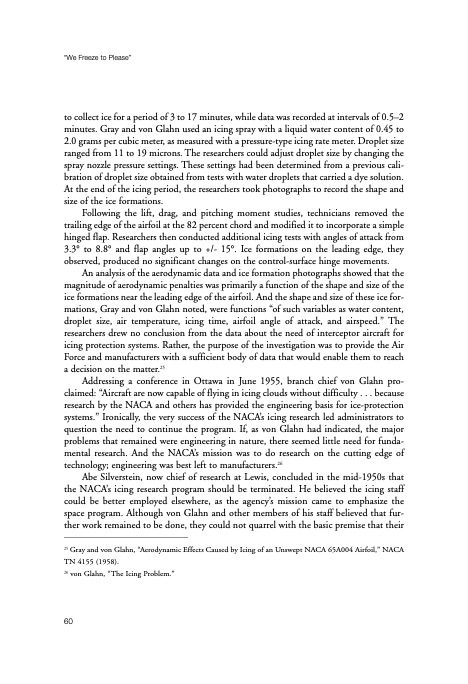
PDF Publication Title:
Text from PDF Page: 073
“We Freeze to Please” to collect ice for a period of 3 to 17 minutes, while data was recorded at intervals of 0.5–2 minutes. Gray and von Glahn used an icing spray with a liquid water content of 0.45 to 2.0 grams per cubic meter, as measured with a pressure-type icing rate meter. Droplet size ranged from 11 to 19 microns. The researchers could adjust droplet size by changing the spray nozzle pressure settings. These settings had been determined from a previous cali- bration of droplet size obtained from tests with water droplets that carried a dye solution. At the end of the icing period, the researchers took photographs to record the shape and size of the ice formations. Following the lift, drag, and pitching moment studies, technicians removed the trailing edge of the airfoil at the 82 percent chord and modified it to incorporate a simple hinged flap. Researchers then conducted additional icing tests with angles of attack from 3.3° to 8.8° and flap angles up to +/- 15°. Ice formations on the leading edge, they observed, produced no significant changes on the control-surface hinge movements. An analysis of the aerodynamic data and ice formation photographs showed that the magnitude of aerodynamic penalties was primarily a function of the shape and size of the ice formations near the leading edge of the airfoil. And the shape and size of these ice for- mations, Gray and von Glahn noted, were functions “of such variables as water content, droplet size, air temperature, icing time, airfoil angle of attack, and airspeed.” The researchers drew no conclusion from the data about the need of interceptor aircraft for icing protection systems. Rather, the purpose of the investigation was to provide the Air Force and manufacturers with a sufficient body of data that would enable them to reach a decision on the matter.25 Addressing a conference in Ottawa in June 1955, branch chief von Glahn pro- claimed: “Aircraft are now capable of flying in icing clouds without difficulty . . . because research by the NACA and others has provided the engineering basis for ice-protection systems.” Ironically, the very success of the NACA’s icing research led administrators to question the need to continue the program. If, as von Glahn had indicated, the major problems that remained were engineering in nature, there seemed little need for funda- mental research. And the NACA’s mission was to do research on the cutting edge of technology; engineering was best left to manufacturers.26 Abe Silverstein, now chief of research at Lewis, concluded in the mid-1950s that the NACA’s icing research program should be terminated. He believed the icing staff could be better employed elsewhere, as the agency’s mission came to emphasize the space program. Although von Glahn and other members of his staff believed that fur- ther work remained to be done, they could not quarrel with the basic premise that their 25 Gray and von Glahn, “Aerodynamic Effects Caused by Icing of an Unswept NACA 65A004 Airfoil,” NACA TN 4155 (1958). 26 von Glahn, “The Icing Problem.” 60PDF Image | History of NASA Icing Research Tunnel

PDF Search Title:
History of NASA Icing Research TunnelOriginal File Name Searched:
sp4226.pdfDIY PDF Search: Google It | Yahoo | Bing
NFT (Non Fungible Token): Buy our tech, design, development or system NFT and become part of our tech NFT network... More Info
IT XR Project Redstone NFT Available for Sale: NFT for high tech turbine design with one part 3D printed counter-rotating energy turbine. Be part of the future with this NFT. Can be bought and sold but only one design NFT exists. Royalties go to the developer (Infinity) to keep enhancing design and applications... More Info
Infinity Turbine IT XR Project Redstone Design: NFT for sale... NFT for high tech turbine design with one part 3D printed counter-rotating energy turbine. Includes all rights to this turbine design, including license for Fluid Handling Block I and II for the turbine assembly and housing. The NFT includes the blueprints (cad/cam), revenue streams, and all future development of the IT XR Project Redstone... More Info
Infinity Turbine ROT Radial Outflow Turbine 24 Design and Worldwide Rights: NFT for sale... NFT for the ROT 24 energy turbine. Be part of the future with this NFT. This design can be bought and sold but only one design NFT exists. You may manufacture the unit, or get the revenues from its sale from Infinity Turbine. Royalties go to the developer (Infinity) to keep enhancing design and applications... More Info
Infinity Supercritical CO2 10 Liter Extractor Design and Worldwide Rights: The Infinity Supercritical 10L CO2 extractor is for botanical oil extraction, which is rich in terpenes and can produce shelf ready full spectrum oil. With over 5 years of development, this industry leader mature extractor machine has been sold since 2015 and is part of many profitable businesses. The process can also be used for electrowinning, e-waste recycling, and lithium battery recycling, gold mining electronic wastes, precious metals. CO2 can also be used in a reverse fuel cell with nafion to make a gas-to-liquids fuel, such as methanol, ethanol and butanol or ethylene. Supercritical CO2 has also been used for treating nafion to make it more effective catalyst. This NFT is for the purchase of worldwide rights which includes the design. More Info
NFT (Non Fungible Token): Buy our tech, design, development or system NFT and become part of our tech NFT network... More Info
Infinity Turbine Products: Special for this month, any plans are $10,000 for complete Cad/Cam blueprints. License is for one build. Try before you buy a production license. May pay by Bitcoin or other Crypto. Products Page... More Info
| CONTACT TEL: 608-238-6001 Email: greg@infinityturbine.com | RSS | AMP |